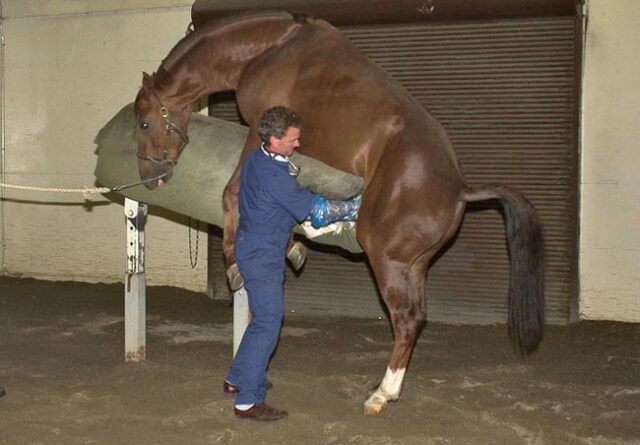By M.L.H. Campbell, BVetMed (Hons) MA, MA, PhD, DipECAR, MRCVS and P. Sandøe, MA, DPhil
Photography: Peter Llewellyn
We suggest that all methods of horse breeding are associated with potential welfare problems, but also that the judicious use of ARTs can sometimes help to address those problems. We discuss how negative welfare effects could be identified and limited, and how positive welfare effects associated with breeding might be maximised. Further studies are needed to establish an evidence base about how stressful or painful various breeding prodedures are for the animals involves, and what the lifetime welfare implications of ARTs are for future animal generations.
Welfare problems relating to the way horses are bred – for example, stress related to long distance transport of breeding stallions or negative side effects of the application of artificial reproduction techniques (ARTs) – have been the occasional subject of conference presentations (for example, Campbell 2012, 2013, Mills 2013). However, they are not discussed a great deal within the horse industry, and have been given no discrete consideration within the academic literature.
This paper aims to address that deficit by reviewing the existing knowledge base on welfare issues in horse breeding, and identifying areas in which data is lacking. We then go on to discuss how negative welfare effects associated with horse breeding could be better identified and limited. ‘Horse breeding’ is defined for the purposes of this article as the processes which lead up to conception, pregnancy, and the management of stallions, broodmares, and foals until weaning.
In this review, we do not address welfare issues in horses that arise from heritable conditions (reviewed by Bettley and others 2012), nor welfare issues related to selective breeding for traits that humans find desirable (for example, extremes of size). Nor do we address the welfare issues of horse abandonment and neglect, identified by various equine charities and in the media as being caused by overbreeding of horses (for example, World Horse Welfare 2013).
Further, we do not, for reasons of space, discuss welfare issues that arise from the management of breeding animals. Instead, starting with the premise that breeding is a legitimate use of horses by people, our focus is on the welfare issues associated with the ways in which horses are bred, whether via ‘natural cover’ (coitus) or ARTs.
In the context of this paper, we are interested in ‘welfare’ in both negative and positive senses. We are concerned with protecting animals from negative experiences such as pain, discomfort, fear, and stress, and also with maximising positive welfare effects. Although attempts to identify positive welfare effects of breeding on horses (for example, whether a mare takes pleasure in raising a foal) run the risk of descending into conjecture, it is possible to associate the fulfilment of animals' needs for social interaction, or the ability to exhibit some other normal behaviours, with positive welfare.
Welfare and health are linked throughout veterinary medicine, and this is particularly true of breeding, where vaccination of breeding stock and their offspring and control of venereal diseases are important tools in safeguarding welfare. However, in this article, we shall focus on issues that are welfare insults, in the sense that they can directly cause pain, discomfort, fear, stress, or other forms of reduced welfare to an animal or its offspring, and shall not consider welfare issues that might arise from infectious disease processes (although infectious disease can, of course, cause pain and distress).
A search of the literature was carried out using the terms: ‘horse breeding and welfare’; ‘broodmares and welfare’; ‘stallions and welfare’; ‘foals and welfare’; ‘welfare effects of assisted reproductive technologies’; ‘welfare effects of assisted reproductive technologies in horses’; ‘equine embryo transfer’; ‘equine artificial insemination’; and ‘equine assisted reproductive technologies’. The search for books and peer-reviewed papers was conducted using the Royal Veterinary College's SCOUT system, PubMed, CAB direct, Biomed Central journals, and the Web of Science. Additionally, ‘soft’ data sources were searched using the same terms.
Technique-associated welfare problems: natural covering
In the wild, a harem stallion and its band of mares interact constantly, year round (McDonnell 2000). Equine courtship and copulatory behaviours, in common with those of most mammalian species, are complex (Chenoweth and others 2014), and are frequently initiated by the mare rather than by the stallion (Chenoweth and others 2014; McDonnell 2000). In domesticated situations, although some breeders allow stallions to run loose with mares at pasture, it is much more common for horses to be bred either ‘in-hand’ (that is, the stallion is led by a human), or using ARTs... To read the complete article you need to be a subscriber
CLICK HERE TO SUBSCRIBE TO BREEDING NEWS
SUBSCRIBERS CAN READ THE COMPLETE ARTICLE BY LOGGING IN AND RETURNING TO THIS PAGE




